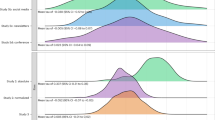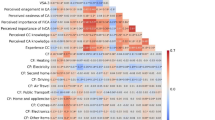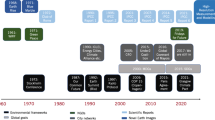Abstract
People with high socioeconomic status disproportionally affect energy-driven greenhouse gas emissions directly through their consumption and indirectly through their financial and social resources. However, few climate change mitigation initiatives have targeted this population segment, and the potential of such initiatives remains insufficiently researched. In this Perspective, we analyse key characteristics of high-socioeconomic-status people and explore five roles through which they have a disproportionate impact on energy-driven greenhouse gas emissions and potentially on climate change mitigation, namely as consumers, investors, role models, organizational participants and citizens. We examine what is known about their disproportionate impact via consumption and explore their potential influence on greenhouse gas emissions through all five roles. We suggest that future research should focus on strategies to reduce greenhouse gas emissions by high-socioeconomic-status people and to align their investments, organizational choices and actions as social and political change agents with climate change mitigation goals.
This is a preview of subscription content, access via your institution
Access options
Access Nature and 54 other Nature Portfolio journals
Get Nature+, our best-value online-access subscription
27,99 € / 30 days
cancel any time
Subscribe to this journal
Receive 12 digital issues and online access to articles
118,99 € per year
only 9,92 € per issue
Buy this article
- Purchase on SpringerLink
- Instant access to full article PDF
Prices may be subject to local taxes which are calculated during checkout


Similar content being viewed by others
References
IPCC, 2018: Summary for Policymakers. In Global Warming of 1.5°C. An IPCC Special Report on the impactsof global warming of 1.5°C above pre-industrial levels and related global greenhouse gas emission pathways, in the context of strengthening the global response to the threat of climate change, sustainable development, and efforts to eradicate poverty (eds Masson-Delmotte, V. et al.) In Press.
Dietz, T., Gardner, G. T., Gilligan, J., Stern, P. C. & Vandenbergh, M. P. Household actions can provide a behavioral wedge to rapidly reduce US carbon emissions. Proc. Natl Acad. Sci. USA 106, 18452–18456 (2009).
Frank, R. H. Under the Influence: Putting Peer Pressure to Work (Princeton Univ. Press, 2020).
Nielsen, K. S. et al. How psychology can help limit climate change. Am. Psychol. 76, 130–144 (2021).
Creutzig, F. et al. Beyond technology: demand-side solutions for climate change mitigation. Annu. Rev. Environ. Resour. 41, 173–198 (2016).
Capstick, S. et al. UNEP Emissions Gap Report 2020; 62–75 (UNEP, 2020) https://wedocs.unep.org/handle/20.500.11822/34432
York, R. Environmental consequences of moral disinhibition. Socius https://doi.org/10.1177/2378023117719612 (2017).
Werfel, S. H. Household behaviour crowds out support for climate change policy when sufficient progress is perceived. Nat. Clim. Change 7, 512–515 (2017).
Supran, G. & Oreskes, N. Assessing ExxonMobil’s climate change communications. Environ. Res. Lett. 12, 084019 (2017).
Lamb, W. F. et al. Discourses of climate delay. Glob. Sustain. https://doi.org/10.1017/sus.2020.13 (2020).
Oswald, Y., Owen, A. & Steinberger, J. K. Large inequality in international and intranational energy footprints between income groups and across consumption categories. Nat. Energy 5, 231–239 (2020).
Chancel, L. & Piketty, T. Carbon and Inequality: from Kyoto to Paris (Paris School of Economics, 2015) http://piketty.pse.ens.fr/files/ChancelPiketty2015.pdf
Wiedmann, T., Lenzen, M., Keyßer, L. T. & Steinberger, J. K. Scientists’ warning on affluence. Nat. Commun. 11, 3107 (2020).
Wright, E. O. Understanding Class (Verso Books, 2015).
Farah, M. J. The neuroscience of socioeconomic status: correlates, causes, and consequences. Neuron 96, 56–71 (2017).
Campbell, K. E., Marsden, P. V. & Hurlbert, J. S. Social resources and socioeconomic status. Soc. Netw. 8, 97–117 (1986).
Kartha, S., Kemp-Benedict, E., Ghosh, E., Nazareth, A. & Gore, T. The Carbon Inequality Era: an Assessment of the Global Distribution of Consumption Emissions among Individuals from 1990 to 2015 and Beyond (Stockholm Environment Institute and Oxfam International, 2020) https://policy-practice.oxfam.org/resources/the-carbon-inequality-era-an-assessment-of-the-global-distribution-of-consumpti-621049/
Anand, S. & Segal, P. Who are the global top 1%? World Dev. 95, 111–126 (2017).
Ravallion, M. Missing Top Income Recipients Working Paper No. 28890 (National Bureau of Economic Research, 2021) https://www.nber.org/papers/w28890
Gössling, S. Celebrities, air travel, and social norms. Ann. Tour. Res. 79, 102775 (2019).
Boyce, J. K. Inequality as a cause of environmental degradation. Ecol. Econ. 11, 169–178 (1994).
Dietz, T., Shwom, R. L. & Whitley, C. T. Climate change and society. Annu. Rev. Sociol. 46, 135–158 (2020).
Robinson, M. & Shine, T. Achieving a climate justice pathway to 1.5 °C. Nat. Clim. Change 8, 564–569 (2018).
Knight, K. W., Schor, J. B. & Jorgenson, A. K. Wealth inequality and carbon emissions in high-income countries. Soc. Curr. 4, 403–412 (2017).
McCright, A. M., Marquart-Pyatt, S. T., Shwom, R. L., Brechin, S. R. & Allen, S. Ideology, capitalism, and climate: explaining public views about climate change in the United States. Energy Res. Soc. Sci. 21, 180–189 (2016).
Nielsen, K. S. et al. Improving climate change mitigation analysis: a framework for examining feasibility. One Earth 3, 325–336 (2020).
Hanna, R., Duflo, E. & Greenstone, M. Up in smoke: the influence of household behavior on the long-run impact of improved cooking stoves. Am. Econ. J. Econ. Policy 8, 80–114 (2016).
Ivanova, D. & Wood, R. The unequal distribution of household carbon footprints in Europe and its link to sustainability. Glob. Sustain. 3, e18 (2020).
Ivanova, D. et al. Quantifying the potential for climate change mitigation of consumption options. Environ. Res. Lett. 15, 093001 (2020).
Gössling, S. & Humpe, A. The global scale, distribution and growth of aviation: implications for climate change. Glob. Environ. Change 65, 102194 (2020).
Lee, D. S. et al. The contribution of global aviation to anthropogenic climate forcing for 2000 to 2018. Atmos. Environ. 244, 117834 (2021).
Litman, T. in Car Troubles: Critical Studies of Automobility and Auto-mobility (eds McLaren, A. T. & Conley, J.) 199–218 (Ashgate Publishing, 2009).
Wynes, S., Nicholas, K. A., Zhao, J. & Donner, S. D. Measuring what works: quantifying greenhouse gas emission reductions of behavioural interventions to reduce driving, meat consumption, and household energy use. Environ. Res. Lett. 13, 113002 (2018).
Gössling, S., Hanna, P., Higham, J., Cohen, S. & Hopkins, D. Can we fly less? Evaluating the ‘necessity’ of air travel. J. Air Transp. Manag. 81, 101722 (2019).
Oswald, L. & Ernst, A. Flying in the face of climate change: quantitative psychological approach examining the social drivers of individual air travel. J. Sustain. Tour. 29, 68–86 (2020).
Baert, S., Lippens, L., Moens, E., Weytjens, J. & Sterkens, P. The COVID-19 Crisis and Telework: a Research Survey on Experiences, Expectations and Hopes IZA Discussion Paper No. 13229 (SSRN, 2020) https://papers.ssrn.com/sol3/papers.cfm?abstract_id=3596696
Jones, C. & Kammen, D. M. Quantifying carbon footprint reduction opportunities for U.S. households and communities. Environ. Sci. Technol. 45, 4088–4095 (2011).
Ahmad, S. & Creutzig, F. Spatially contextualized analysis of energy use for commuting in India. Environ. Res. Lett. 14, 45007 (2019).
Milovanoff, A., Posen, I. D. & MacLean, H. L. Electrification of light-duty vehicle fleet alone will not meet mitigation targets. Nat. Clim. Change 10, 1102–1107 (2020).
Hymel, K. M., Small, K. A. & Van Dender, K. Induced demand and rebound effects in road transport. Transp. Res. B Methodol. 44, 1220–1241 (2010).
Creutzig, F. et al. Fair street space allocation: ethical principles and empirical insights. Transp. Rev. 40, 711–733 (2020).
Heinen, E., Harshfield, A., Panter, J., Mackett, R. & Ogilvie, D. Does exposure to new transport infrastructure result in modal shifts? Patterns of change in commute mode choices in a four-year quasi-experimental cohort study. J. Transp. Heal. 6, 396–410 (2017).
Ramakrishnan, A., Kalkuhl, M., Ahmad, S. & Creutzig, F. Keeping up with the Patels: conspicuous consumption drives the adoption of cars and appliances in India. Energy Res. Soc. Sci. 70, 101742 (2020).
Mattioli, G., Roberts, C., Steinberger, J. K. & Brown, A. The political economy of car dependence: a systems of provision approach. Energy Res. Soc. Sci. 66, 101486 (2020).
Liu, Z. et al. Near-real-time monitoring of global CO2 emissions reveals the effects of the COVID-19 pandemic. Nat. Commun. 11, 5172 (2020).
Kastner, I. & Stern, P. C. Examining the decision-making processes behind household energy investments: a review. Energy Res. Soc. Sci. 10, 72–89 (2015).
Bollinger, B., Gillingham, K. T. & Ovaere, M. Field experimental evidence shows that self-interest attracts more sunlight. Proc. Natl Acad. Sci. USA 117, 20503–20510 (2020).
Fuller, M. C., Portis, S. C. & Kammen, D. M. Toward a low-carbon economy: municipal financing for energy efficiency and solar power. Environ. Sci. Policy Sustain. Dev. 51, 22–33 (2009).
Umit, R., Poortinga, W., Jokinen, P. & Pohjolainen, P. The role of income in energy efficiency and curtailment behaviours: findings from 22 European countries. Energy Res. Soc. Sci. 53, 206–214 (2019).
Ameli, N. & Brandt, N. Determinants of households’ investment in energy efficiency and renewables: evidence from the OECD survey on household environmental behaviour and attitudes. Environ. Res. Lett. 10, 044015 (2015).
Sardianou, E. & Genoudi, P. Which factors affect the willingness of consumers to adopt renewable energies? Renew. Energy 57, 1–4 (2013).
Goulder, L. H., Hafstead, M. A. C., Kim, G. & Long, X. Impacts of a carbon tax across US household income groups: what are the equity-efficiency trade-offs? J. Public Econ. 175, 44–64 (2019).
Boyce, J. K. Carbon pricing: effectiveness and equity. Ecol. Econ. 150, 52–61 (2018).
Baiocchi, G., Creutzig, F., Minx, J. & Pichler, P. P. A spatial typology of human settlements and their CO2 emissions in England. Glob. Environ. Change 34, 13–21 (2015).
Wolske, K. S. & Stern, P. C. in Psychology and Climate Change (eds Clayton, S. & Manning, C.) 127–160 (Academic Press, 2018).
Alvaredo, F. The World Inequality Report (Harvard Univ. Press, 2018).
Mormann, F. Why the divestment movement is missing the mark. Nat. Clim. Change 10, 1067–1068 (2020).
Bioy, H. & Stuart, E. Investing in Times of Climate Change: an Expanding Array of Choices for Climate-Aware Investors (Morningstar, 2020) https://www.morningstar.com/en-uk/lp/investing-in-times-of-climate-change
Moran, M., Treacy, J. & Edey, G. Navigating the European ESG disclosure regime in a post-Brexit world. National Law Review https://www.natlawreview.com/article/navigating-european-esg-disclosure-regime-post-brexit-world (2021).
Ashmore, D. P., Pojani, D., Thoreau, R., Christie, N. & Tyler, N. A. The symbolism of ‘eco cars’ across national cultures: potential implications for policy formulation and transfer. Transp. Res. D Transp. Environ. 63, 560–575 (2018).
Nyborg, K. et al. Social norms as solutions. Science 354, 42–43 (2016).
Rinscheid, A., Pianta, S. & Weber, E. U. What shapes public support for climate change mitigation policies? The role of descriptive social norms and elite cues. Behav. Public Policy https://doi.org/10.1017/bpp.2020.43 (2020).
Veblen, T. The Theory of the Leisure Class: an Economic Study of Institutions (Allen and Unwin, 1899).
Domhoff, G. W. Studying the Power Elite: Fifty Years of Who Rules America? (Routledge, 2017).
Sovacool, B. K., Baker, L., Martiskainen, M. & Hook, A. Processes of elite power and low-carbon pathways: experimentation, financialisation, and dispossession. Glob. Environ. Change 59, 101985 (2019).
Zweigenhaft, R. L. The role of elite education for white men, white women, and people of color in the US corporate elite. Who Rules America? https://whorulesamerica.ucsc.edu/power/elite_education.html (2021).
Vandenbergh, M. P. & Gilligan, J. M. Beyond Politics (Cambridge Univ. Press, 2017).
Vandenbergh, M. P., Dietz, T. & Stern, P. C. Time to try carbon labelling. Nat. Clim. Change 1, 4–6 (2011).
Acuto, M. & Ghojeh, M. C40 cities inside out. Glob. Policy 10, 709–711 (2019).
Alberro, H. Why billionaire climate philanthropists will always be part of the problem. The Conversation https://theconversation.com/why-billionaire-climate-philanthropists-will-always-be-part-of-the-problem-132383 (2020).
Parag, Y. & Janda, K. B. Middle actors and socio-technical change in the energy system from the “middle-out”. Energy Res. Soc. Sci. 3, 102–112 (2014).
Dietz, T. & Whitley, C. T. Inequality, decisions, and altruism. Sociol. Dev. 4, 282–303 (2018).
Meng, K. C. & Rode, A. The social cost of lobbying over climate policy. Nat. Clim. Change 9, 472–476 (2019).
Stokes, L. C. Short Circuiting Policy: Interest Groups and the Battle over Clean Energy and Climate Policy in the American States (Oxford Univ. Press, 2020).
Skocpol, T. & Hertel-Fernandez, A. The Koch network and Republican party extremism. Perspect. Polit. 14, 681–699 (2016).
Mayer, J. Dark Money: the Hidden History of the Billionaires behind the Rise of the Radical Right (Anchor Books, 2017).
Owen, A. & Barrett, J. Reducing inequality resulting from UK low-carbon policy. Clim. Policy 20, 1193–1208 (2020).
Newell, P., Daley, F. & Twena, M. Changing Our Ways? Behaviour Change and the Climate Crisis (Cambridge Sustainability Commissions, 2021) https://www.rapidtransition.org/resources/cambridge-sustainability-commission/
Murray, L. Public Attitudes to Tackling Aviation’s Climate Change Impacts (10:10 Climate Action, 2019).
Frank, R. H. Positional externalities cause large and preventable welfare losses. Am. Econ. Rev. 95, 137–141 (2005).
Mettler, S. & SoRelle, M. in Theories of the Policy Process (eds Weible, C. M. & Sabatier, P.) 103–134 (Routledge, 2018).
Seto, K. C. et al. Carbon lock-in: types, causes, and policy implications. Annu. Rev. Environ. Resour. 41, 425–452 (2016).
Acknowledgements
K.S.N. was supported by the Carlsberg Foundation, grant number CF20-0285. T.D. was supported by Michigan AgBio Research.
Author information
Authors and Affiliations
Corresponding author
Ethics declarations
Competing interests
The authors declare no competing interests.
Additional information
Peer review information Nature Energy thanks Dario Kenner, Daniel Welch and the other, anonymous, reviewer(s) for their contribution to the peer review of this work.
Publisher’s note Springer Nature remains neutral with regard to jurisdictional claims in published maps and institutional affiliations.
Rights and permissions
About this article
Cite this article
Nielsen, K.S., Nicholas, K.A., Creutzig, F. et al. The role of high-socioeconomic-status people in locking in or rapidly reducing energy-driven greenhouse gas emissions. Nat Energy 6, 1011–1016 (2021). https://doi.org/10.1038/s41560-021-00900-y
Received:
Accepted:
Published:
Issue Date:
DOI: https://doi.org/10.1038/s41560-021-00900-y
This article is cited by
-
Exploring the safe and just space for urban and regional Australia
npj Urban Sustainability (2025)
-
The urgency of the Lancet Planetary Health–Earth Commission’s report and IPBES transformations versus the ongoing Z transformation: the need to soften the human sustainability boundaries
Sustainability Science (2025)
-
Evaluating the desirability of energy inequality mitigation strategies within underserved communities in sub-Saharan Africa
Discover Sustainability (2025)
-
Scientist engagement and the knowledge–action gap
Nature Ecology & Evolution (2024)
-
Underestimation of personal carbon footprint inequality in four diverse countries
Nature Climate Change (2024)



